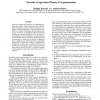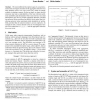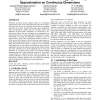111
click to vote
ISCI
2011
14 years 4 days ago
2011
In this second part of our state-of-the-art overview on aggregation theory, based again on our recent monograph on aggregation functions, we focus on several construction methods ...
IPMU
2010
Springer
14 years 3 months ago
2010
Springer
Following the ideas of stronger forms of monotonicity for unary real functions and for capacities, k-monotone and strongly kmonotone aggregation functions are introduced and discus...
ER
2010
Springer
14 years 3 months ago
2010
Springer
Multidimensional models are at the core of data warehouse systems, since they allow decision makers to early define the relevant information and queries that are required to satis...
AAAI
2000
14 years 6 months ago
2000
There are a number of frameworks for modelling argumentation in logic. They incorporate formal representation of individual arguments and techniques for comparing conflicting argu...
MMNS
2007
14 years 6 months ago
2007
In this paper, we show the feasibility of real-time flow monitoring with controllable accuracy in today’s IP networks. Our approach is based on Netflow and A-GAP. A-GAP is a prot...
ECAI
1998
Springer
14 years 8 months ago
1998
Springer
Abstract. We extend different Description Logics by concrete domains (such as integers and reals) and by aggregation functions over these domains (such as min;max;count;sum), which...
KDD
1999
ACM
14 years 9 months ago
1999
ACM
Efficiently answering decision support queries is an important problem. Most of the work in this direction has been in the context of the data cube. Queries are efficiently answer...
PERCOM
2006
ACM
15 years 4 months ago
2006
ACM
In this paper, we propose a new model of resilient data aggregation in sensor networks, where the aggregator analyzes the received sensor readings and tries to detect unexpected d...
EWSN
2009
Springer
15 years 5 months ago
2009
Springer
Abstract. In-network data aggregation is widely recognized as an acceptable means to reduce the amount of transmitted data without adversely affecting the quality of the results. T...



